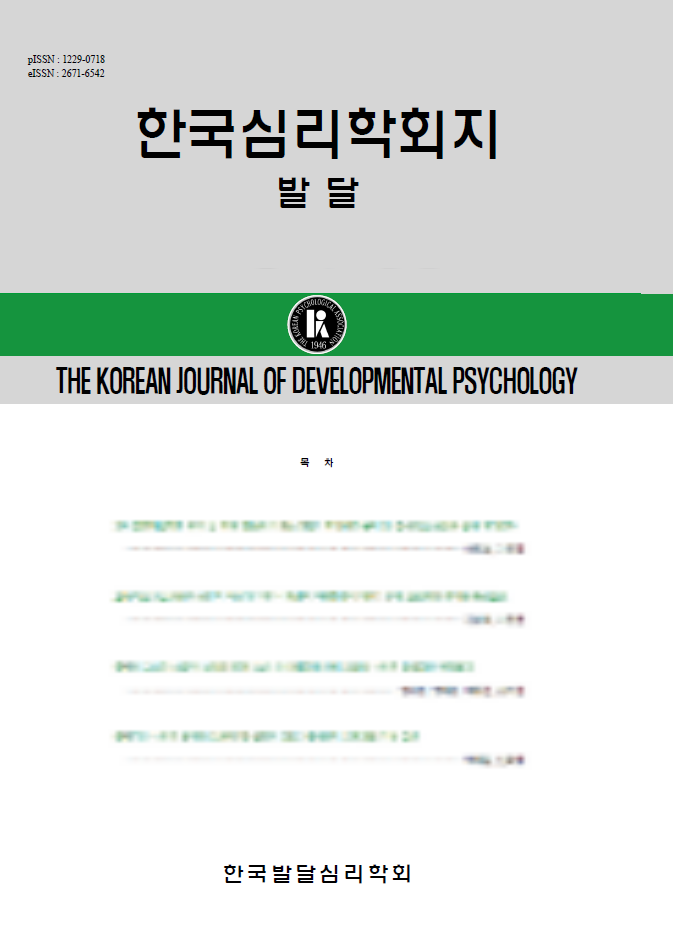open access
메뉴
open access
메뉴 ISSN : 1229-0718
ISSN : 1229-0718

개인의 고유한 특질이 행동과 마음 상태를 유발하는 인과적 원인임을 이해하는 능력의 발달적 변화를 검토했다. 이를 위해서 유치원생(만5세)과 초등학교 2학년(만7세), 4학년(만9세) 아동에게 행위자의 특질 추론이 가능한 행동 정보를 제시하고, 행위자의 특질 유형, 행동, 및 마음 상태를 추론하게 했다. 그 결과, 특질을 명명하는 능력은 학령 전기에 이미 상당한 수준으로 발달하여 학령기 이후에는 더 이상 변화가 없었다. 특정한 특질을 지닌 사람의 행동을 예측하는 능력 또한 학령전기에 우연수준을 넘어서 학령기 이후까지 발달했다. 그러나 유치원생들은 특질 정보를 참조해서 행위자의 믿음, 바람, 정서와 같은 마음 상태를 우연수준 이상으로 추론하지 못했고, 이러한 능력은 5세에서 7세 사이에 발달했다. 이러한 결과는 특질이 마음 상태의 인과적 원인임을 이해하는 능력이 특질과 행동의 관련성에 대한 이해보다 더 늦은 시기에 발달함을 시사한다.
This study examines the developmental change of children's ability to use trait informations for making inferences about behaviors and mental states. A total of 181 kindergarteners, second-graders, and fourth-graders participated in this study. Children were presented two behavioral informations of a story character from which a personality trait could be inferred. Their tasks were to predict and infer the story character's behavior and mental states such as belief, desire, intention, and emotional response. The results indicate that preschoolers have ability to predict behaviors by using the trait informations. However, they could not use the trait informations as a basis for making mental inference. These results suggest that children change from the viewing traits as behavioral regularities to understanding them as causal mediators to produce mental states such as desire, belief, and feeling.
구재선 ; 김혜리 ; 김경미 ; 양혜영 ; 고순남 ; 정명숙, (2006) 아동의 성격 특질에 대한 이해 발달:특질 추론과 상황적,시간적 안정성을 중심으로, 한국심리학회지:발달
김경미 ; 김혜리 ; 정명숙 ; 양혜영 ; 구재선, (2008) 유치원 아동의 마음이론과 사회적 능력의 관계, 한국심리학회지:발달
양혜영 ; 김혜리 ; 김경미 ; 구재선 ; 정명숙 ; 박은혜, (2008) 초등학생의 마음이론과 사회적 능력의 관계, 한국심리학회지:발달
윤정은 ; 송현주, (2007) 아동의 행위자 성향 추론 능력의 발달, 한국심리학회지:일반
Allport,G., (1961) Pattern and growth in personality, Holt, Rinehart & Winston
Astington,J.W., (1991) Intention in the child's theory of mind in : Children's theories of mind: Mental states and social understanding, Erlbaum
Cain, K. M., (1997) Preschoolers' ability to make dispositional predictions within and across domains, Social Development
Fodor,J.A., (1992) A theory of the child's theory of mind, Cognition
Gnepp, J., (1988) Children's use of personality attribution to predict other people's emotional and behavioral reactions, Child Development
Heller, K. A., (1981) Developmental changes in the formation and organization of personality attributions, Child Development
Heyman, G. D., (1999) The use of trait label in making psychological inferences, Child Development
Kuhlmeier, V., (2003) Attribution of dispositional states by 12-month-olds, Psychological Science
Lempers, J. D., (1977) The development in very young children of tacit knowledge concerning visual perception, Genetic Psychology Monographs
Leslie,A.M., (1982) he perception of causality in infants, Perception
Leslie,A.M., (1994) Pretending and believing: Issues in the theory of ToMM, Cognition
Lockhart, K. L., (2002) Young children's beliefs about the stability of traits: Protective optimism, Child Development
Maddi,S.R., (1996) Personality theories: A comparative analysis, Brooks/Cole
Miller, P. J., (1989) Young children's understanding of the psychological causes of behavior: A review, Child Development
Perner,J., (1991) Understanding the representational mind, MIT Press
Perner, J., (1987) Three-year-old's difficulty with false belief: The case for a conceptual deficit, British Journal of Developmental Psychology
Ridgeway, D., (1985) Acquisition of emotion-descriptive language: Receptive and productive vocabulary norms for ages 18 months to 6 years, Developmental Psychology
Song, H., (2007) Can 9.5-month-old infants attribute to an agent a disposition to perform a particular action on objects, Acta Psychologica
Song, H., (2005) Can infants attribute to an agent a disposition to perform a particular action, Cognition
Wellman,H.M., (1990) The child's theory of mind, Bradford
Wellman, H. M., (1988) Young children's reasoning about beliefs, Cognition
Wellman, H. M., (1990) From simple desires to ordinary beliefs: The development of everyday psychology, Cognition
Wimmer, H., (1983) Beliefs about beliefs: Representation and constraining function of wrong beliefs in young children's understanding of deception, Cognition
Whiten, A., (1991) Fundamental issues in the multidisciplinary study of mindreading in : Natural theories of mind, Basil Blackwell
Yuill,N., (1992) Children's conception of personality traits, Human Development
Yuill,N., (1992) Children's production and comprehension of trait terms, British Journal of Developmental Psychology
Yuill, N., (1998) The development of bases for trait attribution: Children's understanding of traits as causal mechanisms based on desire, Developmental Psychology
